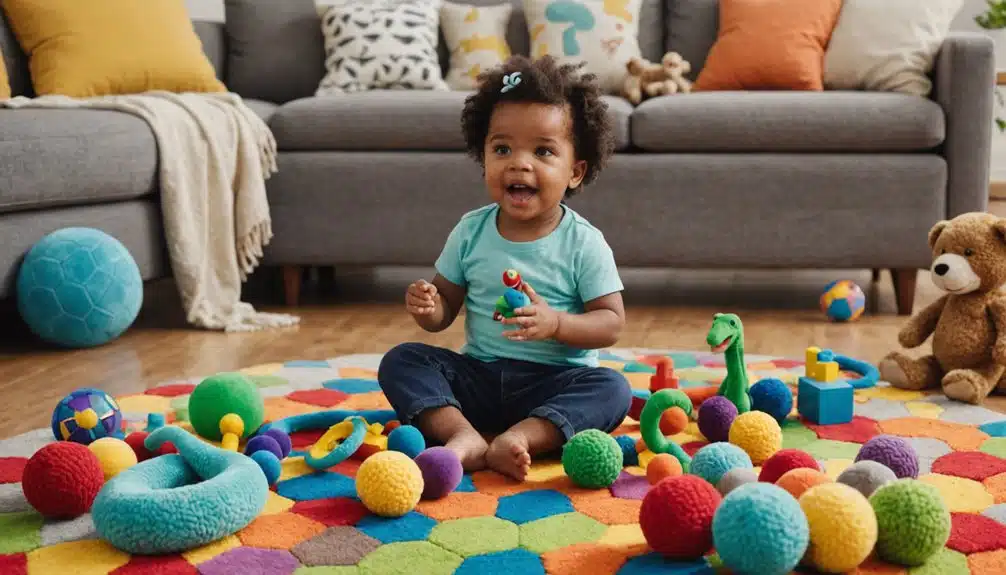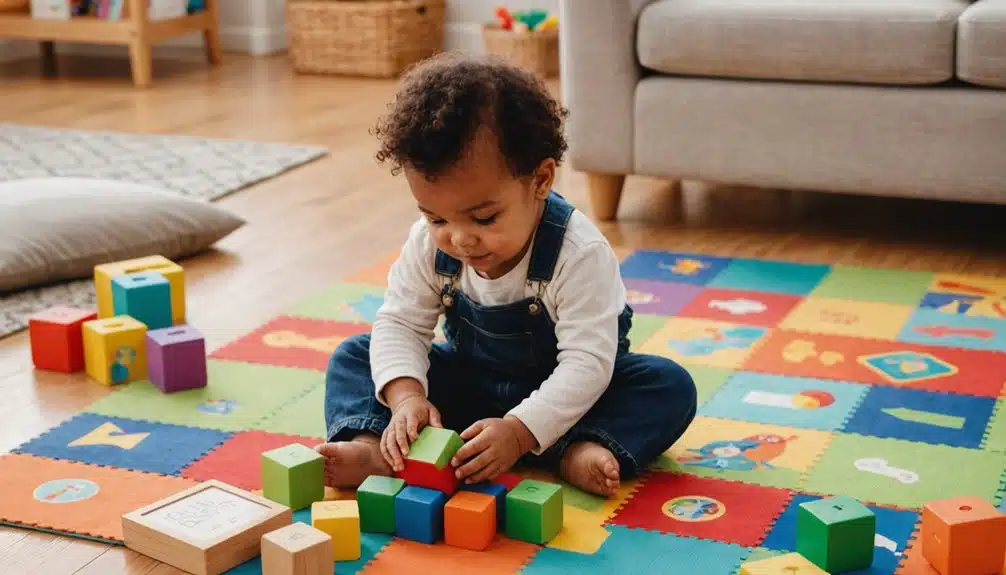Key Takeaways
- Engage toddlers in word games like Scrabble and Charades to enhance verbal skills and critical cognitive abilities.
- Use storytelling techniques to introduce new words, improve language development, and foster creativity.
- Sing nursery rhymes and songs with actions, providing a multi-sensory learning experience and improving motor skills.
- Practice pronunciation with age-appropriate tongue twisters that also enhance fluency and speech clarity.
- Incorporate interactive language learning activities like word association games and reading picture books aloud, enriching vocabulary and comprehension.
Word Games for Vocabulary Expansion
An abundance of word games, such as Scrabble, Charades, and Pictionary, prove to be highly effective educational tools for expanding your toddler’s vocabulary. These games are not only entertaining but also introduce new words, thereby aiding in vocabulary expansion. They provide a fun and engaging way to improve language development in toddlers.
Playing word games with toddlers encourages the use and growth of their verbal skills. An active exchange of words and phrases during these games improves their listening abilities, which is a cornerstone of effective communication. The simple act of naming objects and explaining new words during gameplay can greatly help toddlers learn and retain vocabulary.
Moreover, word games foster active participation, critical cognitive skills, and social interaction. These aspects are essential for speech and overall language development in toddlers. Through these games, toddlers can grasp the complexities of language in a more relaxed and enjoyable environment.
In addition, integrating elements of pediatric speech therapy into these games can help guide toddlers more effectively toward achieving specific speech and language goals.
Storytelling: A Language Boost
The power of storytelling as a tool for language development in toddlers is significant and multi-dimensional. By examining engaging storytelling techniques, we can understand how these methods expose toddlers to new expressions, ideas, and vocabulary, effectively enhancing their language skills. Moreover, the interactive nature of storytelling not only bolsters a child’s communication skills but also nurtures the critical parent-child bonding process, creating a conducive environment for learning. Additionally, storytelling can be a tool to teach toddlers about self-care skills, an essential part of their overall development, reinforcing the importance of activities like dressing, eating, and grooming.
Engaging Storytelling Techniques
Utilizing the power of storytelling can significantly improve language development in toddlers. Storytelling is an engaging way to introduce new words and concepts, while expressive voices can make the narrative more captivating, maintaining a child’s attention and interest. Gestures, too, play an essential role in this process, providing visual cues that reinforce understanding and enrich the storytelling experience.
Encouraging toddlers to retell stories is another effective technique. This activity not only improves memory retention but also hones their narrative skills, setting a solid foundation for future communication. Try to create a supportive environment where they feel confident about expressing themselves, and remember, practice makes perfect.
Incorporating props and interactive elements into storytelling can stimulate toddlers’ imagination and make the learning process more enjoyable. Props, such as puppets or toys, can bring stories to life, fostering an immersive experience. Interactive elements, like asking questions or encouraging participation, can further boost their comprehension and engagement.
Additionally, pediatric occupational therapy often utilizes play-based activities, like storytelling, to address sensory processing and cognitive abilities in children, providing an engaging and fun way for children to improve their communication skills.
Impact on Vocabulary Enhancement
How does storytelling contribute to vocabulary development in toddlers? Storytelling is a potent tool for enriching vocabulary, as it introduces new words in a meaningful context, fostering language development. This activity provides a language boost that significantly impacts a child’s capacity to articulate thoughts, ideas, and emotions.
Here are three ways storytelling can enrich vocabulary:
- It expands a child’s vocabulary: By exposing toddlers to new words in the context of a story, they are more likely to understand and remember them. This expansion of vocabulary is a fundamental aspect of language development.
- It improves comprehension: As toddlers hear stories, they learn to understand complex sentences and ideas, which aids their comprehension skills.
- It encourages speech: Encouraging toddlers to tell stories allows them to practice using new words and expressing their thoughts more effectively, contributing to speech development.
Incorporating storytelling into daily activities with toddlers can significantly enrich their vocabulary. By doing so, we not only foster their language development but also stimulate their cognitive abilities and creativity. Consequently, storytelling is a crucial activity for promoting speech development in toddlers.
Moreover, storytelling allows for interactive dialogue and enhances social skills development by encouraging active listening, turn-taking, and empathy, which are integral to a child’s overall development.
Singing Songs and Nursery Rhymes

Singing tunes and lullabies greatly enhances language development in toddlers by using the power of melody and rhythm. This enjoyable and impactful activity improves language development through rhythm and repetition, vital elements that facilitate the learning process for toddlers.
The repetitive nature of tunes and lullabies aids in the retention of new words and patterns in language. This repetition lays a strong foundation for vocabulary building, helping toddlers recognize and remember linguistic patterns. Subsequently, this fosters an understanding of language structure and syntax, further enhancing their verbal skills.
Moreover, the social aspect of singing tunes cannot be overlooked. It cultivates toddlers’ social skills by encouraging interaction, participation, and communication. The shared experience of singing songs or reciting lullabies fosters a sense of community, promoting social bonding and cooperation.
In addition, incorporating actions and movements into tunes provides a multi-sensory learning experience. These physical elements help toddlers retain new vocabulary and improve speech development. The combination of auditory, visual, and kinesthetic stimuli provides a thorough learning environment, reinforcing language acquisition and development in toddlers.
Furthermore, such activities can also help improve the child’s motor skills, promoting overall physical development. This benefit aligns with the objectives of pediatric physical therapy, which focuses on enhancing children’s motor skills and physical growth.
Playful Rhyming Activities
Fun rhyming activities strengthen phonemic awareness in toddlers and serve as an essential tool for speech development. They enable toddlers to recognize and form rhyming words, thus enriching their language skills. By singing nursery rhymes and engaging in rhyming games, learning becomes an enjoyable and interactive process for them.
Participating in rhyming activities with your toddlers can lead to:
- A noticeable enhancement in their vocabulary.
- A substantial increase in their cognitive development.
- Improved memory retention.
Reading rhyming books together can further this learning adventure. It helps toddlers identify patterns in language and enriches their vocabulary. Rhyming activities, therefore, serve a dual purpose of learning and entertainment, making them a necessary addition to your toddler’s daily routine.
In addition to these advantages, these activities are known to assist in toddlers’ overall growth. They improve phonemic awareness, an essential skill for speech development. Including fun rhyming activities in your toddler’s daily routine can, thus, act as a stepping stone for their linguistic exploration.
Incorporating the principles of the DIR/Floortime approach into these rhyming activities can offer additional benefits, enhancing children’s social, emotional, and cognitive capacities through personalized developmental processes.
Tongue Twisters: Fun Pronunciation Practice

Tongue twisters, as a playful and engaging form of speech exercise, offer a variety of benefits for toddlers in the early stages of speech development. Through the careful selection of age-appropriate twisters, we can foster improvement in speech clarity, articulation, and fluency, thereby enhancing phonological awareness and speech production skills. Additionally, by incorporating these twisters into everyday play, we can create a fun and stimulating environment conducive to the development of communication abilities in toddlers. Notably, tongue twisters can also contribute to the early intervention strategies used in pediatric occupational therapy, potentially aiding children with developmental delays.
Selecting Age-Appropriate Twisters
Speech development exercises, such as age-appropriate tongue twisters, offer an engaging and effective way to hone toddlers’ pronunciation and enunciation skills. These playful and challenging exercises are a fantastic way to involve toddlers in active speech practice that is both enjoyable and advantageous.
When selecting tongue twisters, it is critical to choose age-appropriate ones that will not frustrate the child but instead enhance their confidence in communication. The tongue twisters should be simple, fun, and composed of sounds and words the toddler is familiar with. The emphasis is on practice and gradual improvement, not on immediate perfection.
- Start with short and straightforward tongue twisters, focusing on one or two sounds. For example, “Big blue bug” can help toddlers practice the ‘b’ sound.
- Progress to more intricate twisters as the toddler’s pronunciation and enunciation skills improve.
- Regularly switch up the twisters to keep the practice exciting and fresh.
Through these exercises, toddlers will not only learn to articulate sounds more clearly and accurately but also develop their speech muscles, enhancing their overall speech fluency. This approach makes speech therapy an enjoyable experience for toddlers. Moreover, these activities can be particularly beneficial for those with Sensory Processing Disorder (SPD), aiding in their sensory integration and modulation.
Benefits of Tongue Twisters
Building on the previous discussion about choosing suitable tongue twisters for toddlers, it’s essential to understand the many benefits that these fun exercises offer for speech development. Tongue twisters are valuable tools for improving language development in young children. Challenging toddlers to repeat phrases or sentences filled with similar sounds helps refine pronunciation skills and enhance speech clarity.
Tongue twisters also stimulate phonological awareness, an essential aspect of early language and literacy development. This involves recognizing and manipulating the sound structures of language, enabling children to distinguish between similar-sounding words and enhancing their auditory discrimination skills.
Furthermore, practicing tongue twisters can significantly enhance a child’s communication skills. As toddlers work to articulate these tricky phrases, they gain confidence in their speaking abilities. This confidence, along with improved pronunciation and diction, contributes to more transparent and more effective communication.
Interestingly, these benefits of tongue twisters align with the development of fine motor skills in children. These skills are essential for tasks like writing and drawing that also require precision and control.
In essence, tongue twisters make pronunciation practice enjoyable and effective, turning it from a tedious task into a fun and engaging activity. When used appropriately, they offer a variety of benefits that go beyond just entertainment, playing a valuable role in promoting thorough speech development in toddlers.
Incorporating Twisters Into Play
Incorporating tongue twisters into a toddler’s playtime can be a fun and effective method for enhancing their speech development. Tongue twisters are engaging exercises that provide an enjoyable way for toddlers to practice pronouncing words. They challenge and stimulate a child’s linguistic abilities, promoting speech clarity and development.
By incorporating these playful exercises into a child’s play, you can turn speech practice into a delightful game. Tongue twisters can be integrated into diverse activities, such as storytelling, songs, or rhymes, and they can be tailored to suit a child’s age, interests, and language proficiency.
Here are some ways to include tongue twisters in playtime:
- Create a tongue twister game where the child has to say the twister after hearing it.
- Include tongue twisters in storytime by reading books that contain them.
- Teach them songs or rhymes that incorporate tongue twisters.
Reading Books Aloud Together
While it may seem like a simple pastime, reading books aloud with your toddler plays a crucial role in enriching their language development. This activity introduces your child to new vocabulary and complex sentence structures that stimulate their cognitive abilities.
Choosing age-appropriate books with rich language content encourages active engagement, which is essential in improving comprehension. As you read together, your child will begin to recognize patterns in language, supporting vocabulary building and speech development. This recognition not only enriches their language skills but also enhances their ability to communicate intricate thoughts and emotions through verbal expression.
Further, reading books aloud together fosters a love for reading and language, an essential factor in lifelong learning. To encourage this, consider attending storytime events at libraries or bookstores. These events, designed to promote children’s love for reading, can further elevate your child’s language development.
In essence, reading books aloud with your toddler is a powerful tool in their language development adventure. This home activity, coupled with your constant encouragement, will significantly contribute to the development of your child’s speech and language skills.
Exploring Homonyms and Word Definitions

Continuing from the practice of reading together, another excellent way to improve your toddler’s speech development is to explore homonyms and word definitions. This engaging activity not only enhances language skills but also nurtures critical thinking.
Homonyms are words that sound the same but have different meanings. For instance, the word ‘bat’ could refer to a flying mammal or sports equipment. Please encourage your child to identify such words, thereby expanding their vocabulary and comprehension.
Understanding word definitions is another vital aspect. Explain the meanings of words and their context in sentences. For example, define ‘happy’ as feeling joy or contentment and illustrate its usage in different scenarios.
Engage your child in word association activities to reinforce learning. This effective communication tool allows them to draw connections between words, their meanings, and contextual usage.
Here are some strategies to help you:
- Use picture books to illustrate homonyms, making it easier for toddlers to understand.
- Utilize everyday conversations to explain word definitions.
- Create a fun word association game using homonyms and their meanings.
Frequently Asked Questions
How can I encourage speech development in my toddler?
Talk, read, and sing with your toddler every day to encourage speech development. Simple activities like naming objects, playing word games, and repeating sounds help build their vocabulary and confidence in speaking.
How Can I Stimulate My Toddler’s Speech?
Engage in regular conversations, use simple language, repeat words, and imitate sounds to stimulate your toddler’s speech. Reading books, singing songs, playing interactive games, and describing daily activities are also effective strategies for speech development.
How to Give Speech Therapy at Home for a 2-Year-Old?
To provide speech therapy at home for a two-year-old and engage them in activities that promote language use. Reading, singing, playing interactive games, and maintaining consistent routines can effectively stimulate speech development in toddlers.
What Are 3 Techniques Used to Encourage Toddlers to Speak Correctly?
Three effective techniques include modeling, where caregivers demonstrate correct speech, positive reinforcement for attempts at correct speech, and repetition of words and sounds for practice and improved pronunciation. Gentle correction also aids in speech development.
How to Teach Your Child Speech Therapy at Home?
To teach your child speech therapy at home, incorporate interactive language-focused activities into daily routines. Use playtime for expressive language practice, video modeling for improved learning, and alternative communication methods to strengthen language skills.
Conclusion
To sum up, these seven home activities epitomize a limitless reservoir of linguistic escapades, capable of sparking monumental progress in toddler speech development. By utilizing word games, storytelling, songs, rhymes, tongue twisters, reading, and homonyms exploration, a matchless linguistic aptitude in toddlers can be nurtured. This systematic strategy offers an exceptional foundation for enriching vocabulary, pronunciation, understanding, and holistic language advancement.


Recent Comments